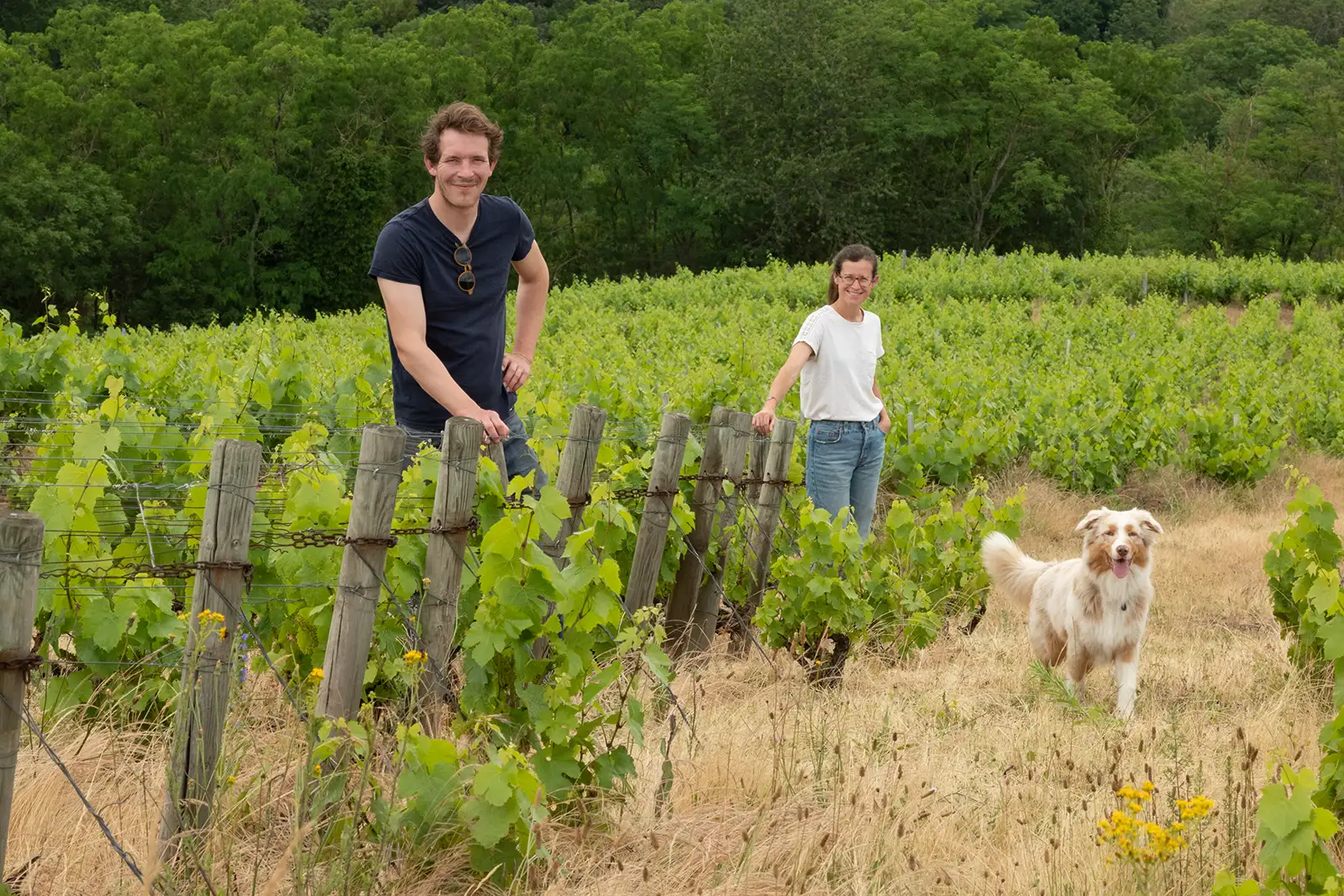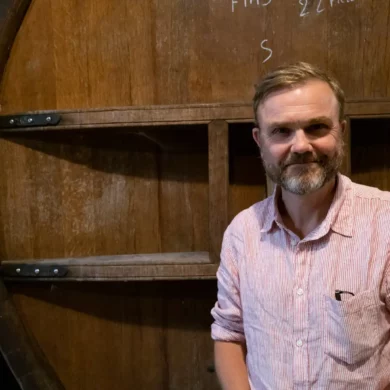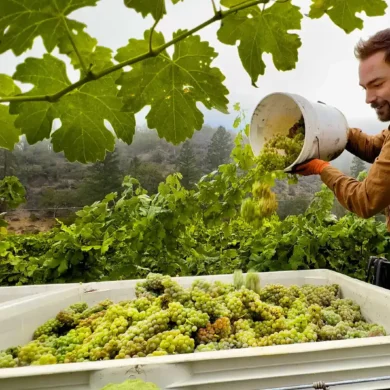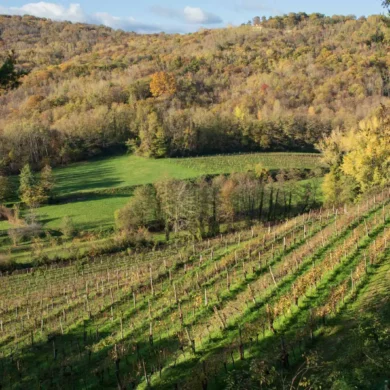If you are a Beaujolais watcher, you probably conjure an image of La Madone every time you think of Fleurie. The tidy chapel whose hill is draped with vines certainly makes for a nice postcard or inspired art. But there is another side to this esteemed village and its wines that feels hidden away and off the well-worn path. It’s called Les Labourons, a small enclave of vineyards and patchy forest that is tucked away over the hills to the west and hidden from most views.
On a weekend stay this summer, I peered into Les Labourons for the first time from the top of La Tonne, where a tiny home I was renting from winemaker Phillipe Aufranc was located. What is that place? I wondered, gazing down into a verdant valley of remarkable beauty and tranquility. Then I realized that, somewhere down there, was my appointment for the next afternoon: at Domaine Valma.
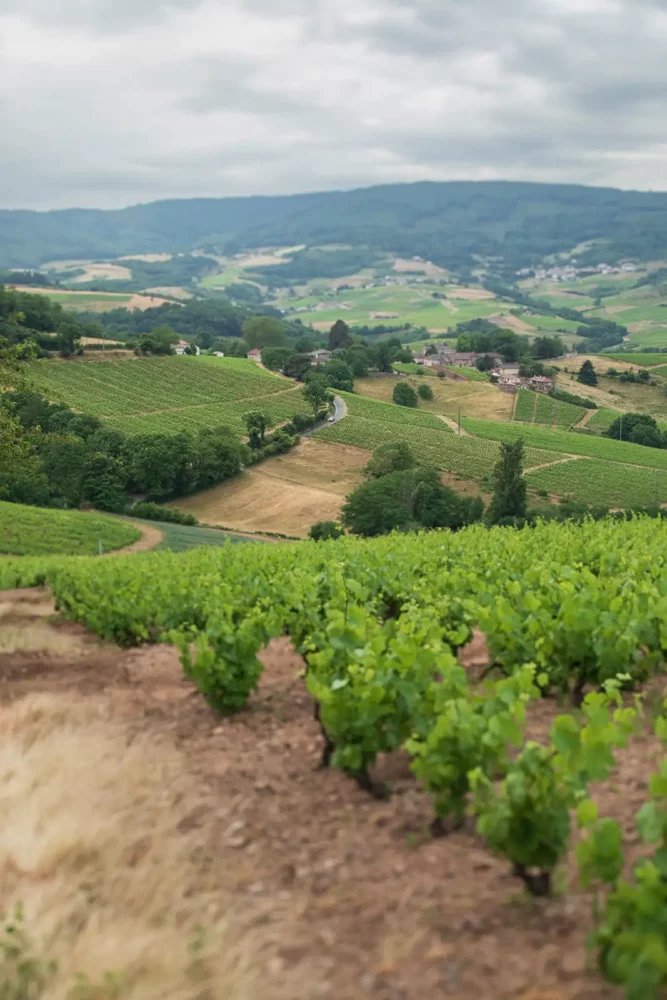
Les Labourons has the same broken pink-granite soil as the rest of Fleurie, but it slopes away to the west, more oriented toward the Beaujolais-Village of Vauxrenard. On a vineyard map, Les Labourons appears like a hook off the northwestern edge of the Fleurie AOC, its land more diversely parceled out.
The next day, after meeting Jean-Marc Burgaud in Morgon, I ambled over the Col des Labourons and dropped down into the small enclave where this young start-up winery was apparently located. I say “apparently” because Beaujolais is well signed. I’d just passed one for Anne-Sophie Dubois, and now here was another for Domaine de la Bouronière and Domaine Pardon … right where Google Maps told me to turn for Domaine Valma.
Oh right. They’re new, I remembered. They probably don’t have a sign up yet.
Turns out, I was going to a small house party. After parking my car and wandering down a driveway, I heard friendly laughter and clattering dishes, and after my timid bonjour into an open house door, Stéphane Mathieu appeared and welcomed me into Domaine Valma — that is, the home of Stéphane and his wife, winemaker Valentine Mathieu. There were two other couples there, with their infants and toddlers no less, enjoying a leisurely Saturday lunch. Yes, I was interrupting, but no, I wasn’t really interrupting. They were expecting me. And they were all too happy to tell me what they’d learned so far as a baby winery themselves.
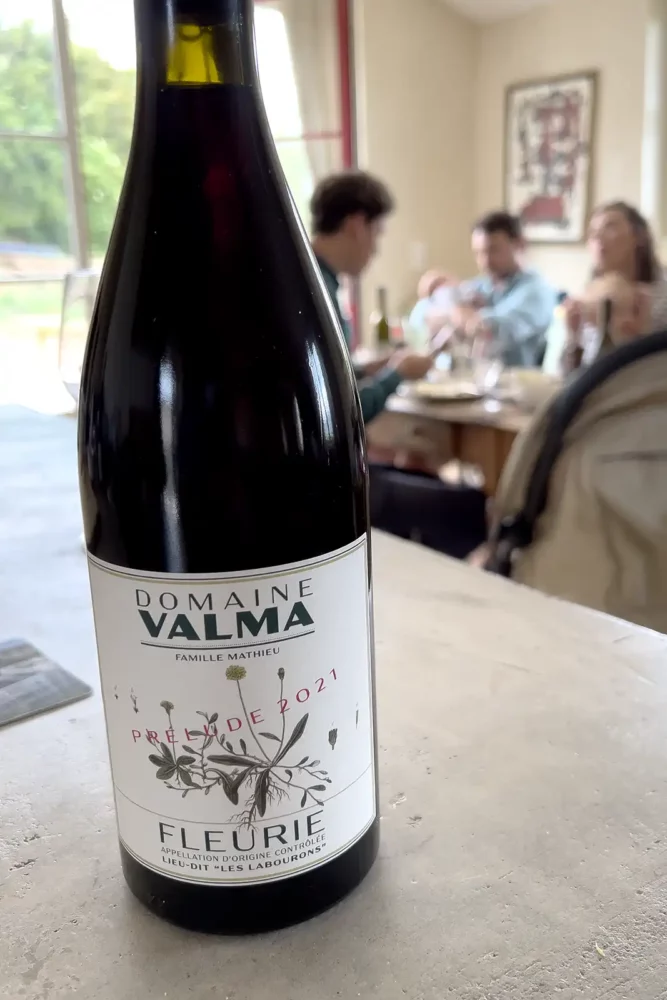
“It is only day three,” Stéphane told me as he poured a glass of the winery’s 2021 Fleurie, called “Prélude.” “Vintage ’21, vintage ’22 and now, vintage ’23, so yes, it is only day three.”
I was already sensing that the long-story arc of wine was not lost on this couple. How could it not be? Winemaking is extremely hard work, the toil and tumult from nature keeping you constantly on your toes. And that’s not to mention the bureaucracy, the regulations, the labor force, the whims of the market. To risk everything you’d worked for and go all-in on a vineyard and winery from scratch? I admire risk-takers for the same reason I admire professional athletes: because I am not one.
“What has been your biggest challenge starting out?” I asked Stéphane.
“Everything,” he replied.
Driven by Independence
Valentine is originally from Paris, but Stéphane has had “a foot in Beaujolais” his whole life, having been born in Pierres Dorées and later growing up in Lyon, where the region’s wines have long been a part of the city’s culinary DNA. They met in 2011 at a school in Bordeaux where they were learning wine marketing and communication. By 2014, they were married and beginning to sow the seeds of Domaine Valma as “something for our family.”
“Independence, to be alone, to build it by our home with no investor, no help from parents or friends,” Stéphane told me. “Just Valentine and I. That’s the most important thing for us.”
“When we arrived, we were very seduced by the place.”
Valentine Mathieu
Winemaker
Domaine Valma
But they weren’t satisfied with being anywhere in Beaujolais; they wanted the right kind of vineyard. Their preference was for vines with potential in Fleurie or Juliénas, as well as maybe some Beaujolais-Villages vineyards with altitude. In Fleurie and Juliénas, they began to scout specifically for north-facing vineyards, a strategy that is antithetical to what has often been regarded as the first requirement of grand vineyard sites in France — at least, before the climate change era.
“It was a focus to be at high altitude and not looking south,” Stéphane said. “We had many opportunities to buy in a lesser altitude part of the village and looking south. But for us, even if this is the best terroir in Fleurie on paper, we were not happy with that. We want to catch freshness.”
Their focused search lead them to Les Labourons, and they immediately felt a connection. “When we arrived, we were very seduced by the place,” said Valentine.
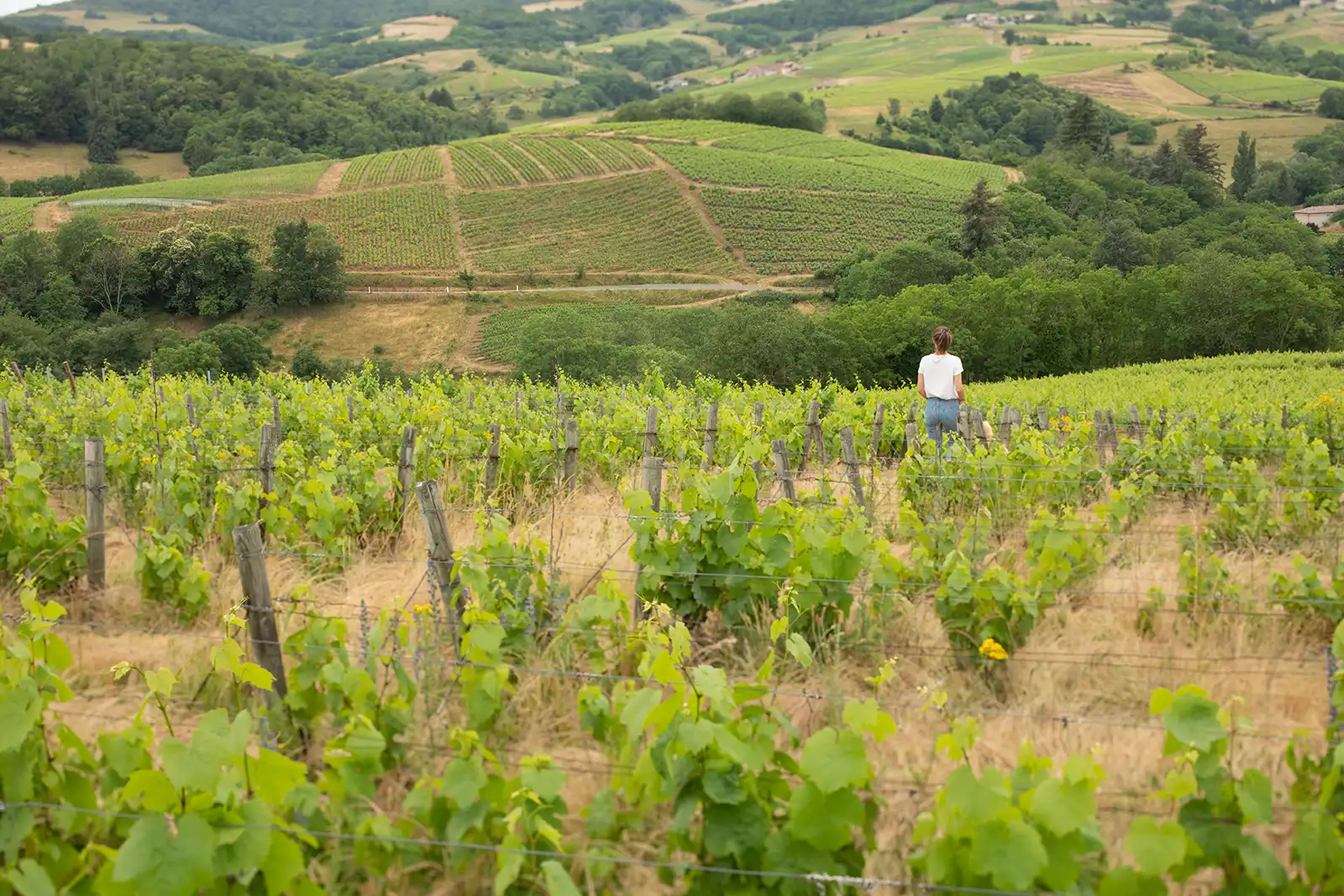
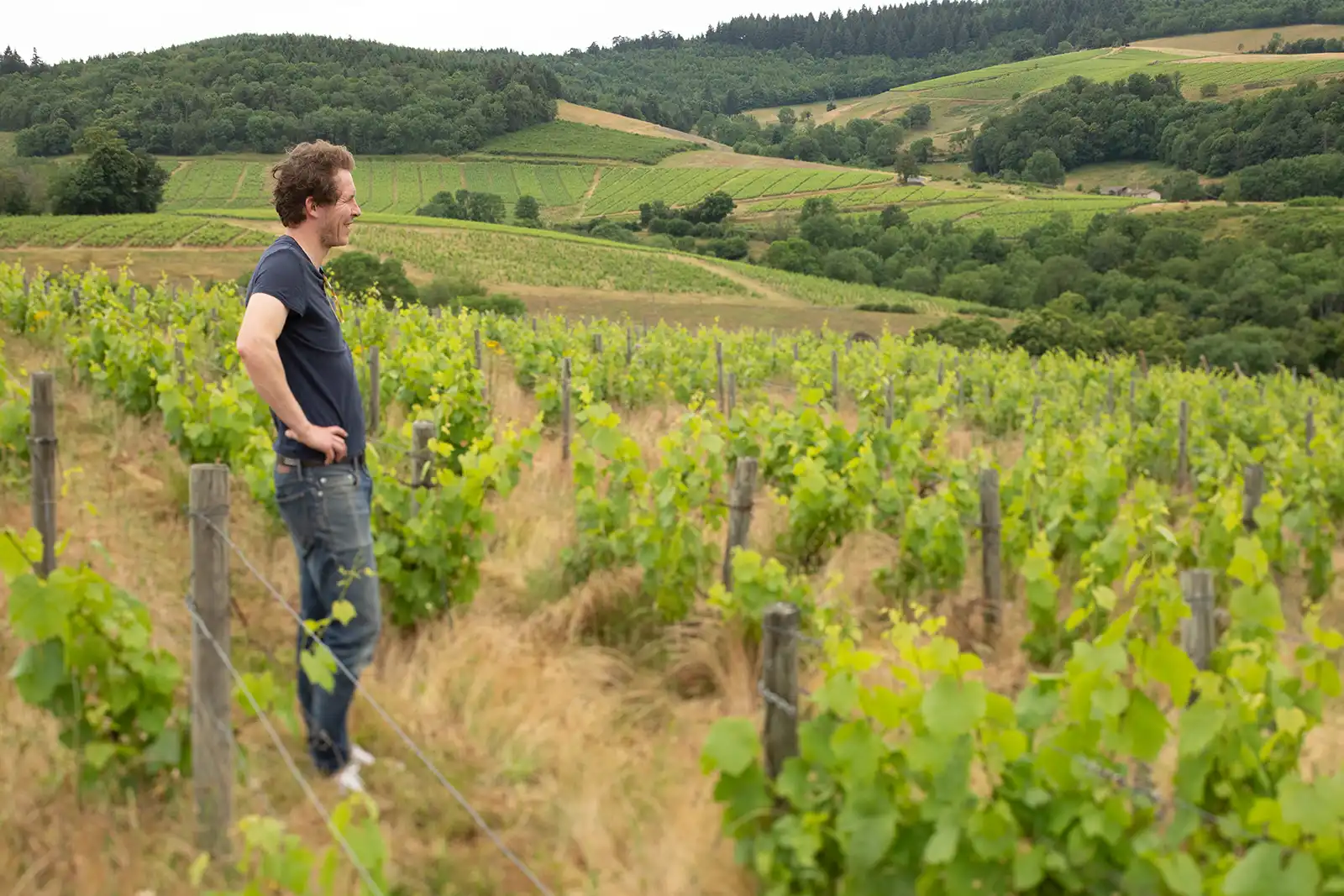
On the market were two parcels that ticked all the boxes. One vineyard contained very young vines which faced north — their eager fruit would likely preserve acidity and avoid flabbiness.
The other slope faced west but contained old vines planted in the 1950s, which would provide depth and concentration to the wine, and be more resilient to extreme weather. With its biodiversity from nearby forests and mixed farms, Les Labourons also seemed to have a unique microclimate that could prove to be beneficial.
But all of this is conjecture when you are starting out. It takes many vintages to not only sort out the storyline of your terroir, but to operate smoothly. And despite their wishes to be independent, there was no way of succeeding without ample guidance from mentors.
Gratitude for Their Beaujolais Community
Back in 2019, Valentine resigned from a full-time position with Rémy Cointreau to jumpstart their domaine dreams. Her first step was pursuing a Baccalauréat agricole from their home in Paris. The couple had two young children, but Valentine was determined to balance parenthood with her studies because the latter would one day support the former.
With Champagne nearby, she interned with Alexandre Chartogne-Taillet at Chartogne-Taillet, considered by many to be one of the region’s top grower-producers. While the Mathieus never aspired to make sparkling wine, there was plenty of applicable things to learn, such as the art of pruning and the role of barrels on vinification.
However, the goal was always to return to Stéphane’s stomping grounds in Beaujolais. “We really like the region. Stéphane used to be here a lot when he was younger, and its not too far from [friends and family in] Paris. And we love the kind of wine that you can taste here.”
“After that, when I arrived here [at Domaine Valma], it was like ‘OK, I know nothing.’ That was only one vinification.”
Valentine Mathieu
Winemaker
Domaine Valma
In April 2020, as the pandemic tightened its grip on the world, Valentine sought out the Geoffray family of Château Thivin in the southern Beaujolais Cru of Mont Brouilly. Because of COVID restrictions, her classroom wasn’t the vineyard as much as it was the phone. But she quickly learned the Beaujolais ropes and by August, degree in hand, she was able to assist with Château Thivin’s vinification of the 2020 vintage.
“After that, when I arrived here [at Domaine Valma], it was like ‘OK, I know nothing,'” she said. “That was only one vinification.”
The 2021 vintage would be their leap of faith. Valentine credits vine expert François Dal as well as botanist Gérard Ducerf with being instrumental in helping her understand the behavior of the vineyards. In particular, she cited Ducerf, who taught her how to study the presence of certain herbs, weeds and grasses for clues on the overall health of the vineyard’s ecosystem. (One such plant now adorns their label). The whole experience affirmed Valentine and Stéphane’s desire to convert their operation to organic from the beginning, and as we walked through their west-facing vines in Les Labourons later that afternoon, they noted the return of thigh-high grasses which were not able to grow just two years earlier.
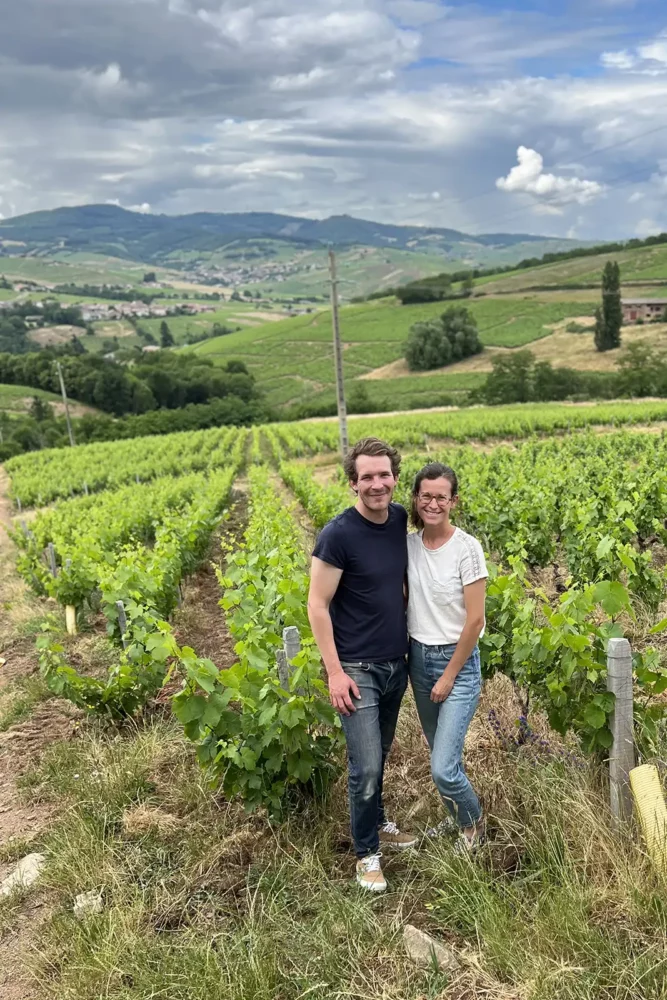
In the cellar, Valentine enlisted the guidance of Beaujolais icon Jacques Néauport, who was a contemporary and peer of Jules Chauvet, the man often credited with kickstarting the natural wine revolution in Beaujolais and across France. In particular, Néauport guided her through the subtleties of the semi-carbonic maceration process.
“Independence, to be alone, to build it by our home with no investor, no help from parents or friends. Just Valentine and I. That’s the most important thing for us.”
Stéphane Mathieu
Co-Owner
Domaine Valma
But the rigors of day-to-day winemaking cannot be overlooked. When I asked about the labor situation, Valentine was candid that the issue for them was not finding people, it was finding people with the right skills and passion for the wage they could offer. Plus, you have to have a contingency plan for the unexpected, like when your tractor breaks down and you’ve never thought about becoming a mechanic as well. (Solution: ask your handy neighbor).
In fact, that was the overriding theme of our conversation: weirdly, to achieve a vision of independence, you cannot do it alone.
About That First Vintage
Whether its the earthy sting of mushrooms conjuring the fall in an aged Bordeaux, or a bright little Muscadet blooming like the spring, some wines flip a seasonal switch the moment you smell them. For me, Domaine Valma’s 2021 “Prélude” Fleurie, was summertime strawberries all the way. Ripe, juicy, fleshy yet textural and with a clear persistence you only get from Gamay in granite. I was immediately impressed.
Stéphane was making coffee for his friends while Valentine tended to one of the kids, leaving me a quiet moment to taste and study the wine. Debut effort? It didn’t seem so. Clearly, guidance from the likes of Chartogne-Taillet, Geoffray, Dal, Ducerf and Néauport was studiously translated in the wine, but so was something else. “Prélude” was fun. It didn’t feel calculating or restrained.
“We are quite new in the vineyard, but we are passionate about wine,” Stéphane had said during introductions. And that was it. More important than its natural bonafides, Domaine Valma’s debut wine came from a place of honesty and care.
Word spread locally about their work, and soon they had an American importer — Bryan Garcia of Cork Hoarder — knocking on their door. (They now have additional distribution through Becky Wasserman). As they eased into their second vintage, they appeared to be hitting their stride. But ultimately, the 2022 vintage was dramatically different than 2021.
“It was stressful,” Stéphane noted. “In ’21, it was … easy to understand. In ’22, something different. The grapes looked perfect, but inside the grapes, the balance was difficult to understand.”
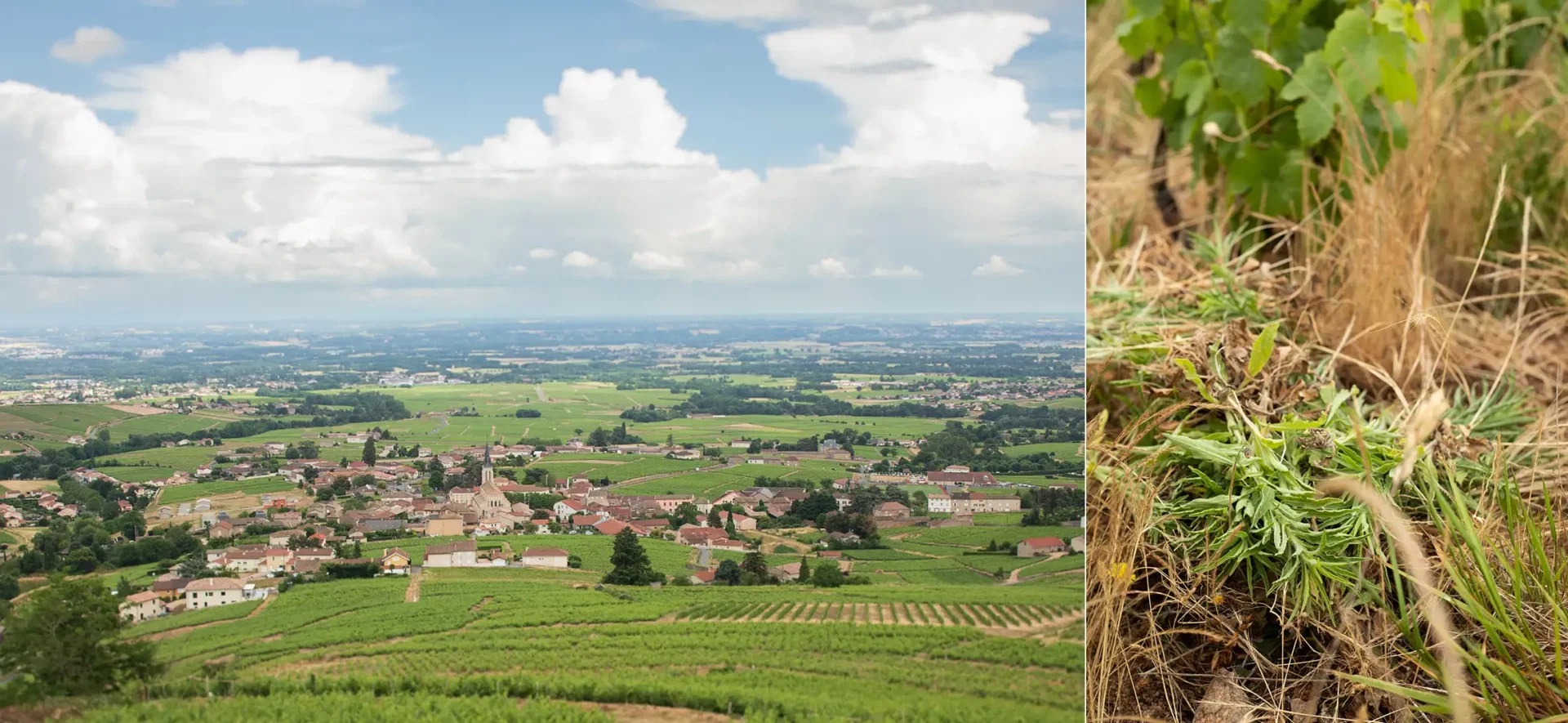
Still, they’re confident that they are finding their footing, and now they have two more parcels to work with in Fleurie, which — if everything goes according to plan for the Fleurie AOC — could be Premier Cru level in the future. One plot is in La Chapelle des Bois, the other on La Madone, the iconic chapel-topped hill.
To conclude my visit, I followed Stéphane in my car out to their new parcel on La Madone. It is a steep, brittle slope with back-breakingly low vines, but the view over the village and toward Mont Blanc is stunning, and more importantly for them, they are eager to work with such a famous lieu-dit, even if it is south facing. After all, La Madone is Fleurie.
There is no idyll time for a startup winemaker. While we talked, Stéphane bent over and uprooted several noxious weeds that he said were a sign of the soil’s history with glyphosate (also known as Roundup). “They can grow here but they take over and the other herbs cannot grow,” he noted. They planned another organic conversion, but it would take time. Everything takes time. And everything is difficult. But raising a family in Les Labourons and making a jolly drink like Beaujolais certainly has its appeal.

I Like Independence, Too
As a wine writer, nothing is more satisfying than choosing my own stories to tell on the pages of this website. And while I don’t have anything as expensive as a tractor to fix, I do need financial support for the work I do: website hosting, technical development, time spent writing, and yes, a rental car and tiny home rental in Beaujolais so I can go where the real stories are happening.
Subscribe to Opening a Bottle and unlock hundreds of pages of paywall content including winery profiles, my Wines to Admire wine reviews and live online classes. At only $49/year, it is a steal. And if you work in the wine industry, my professional group subscriptions offer 5 log-ins and tons of perks for just $139/year.
Help a fellow wine obsessive out and consider a subscribe. Merci beaucoup.
Correction: An earlier version of this story stated that 2021 was a hot vintage, but that was not the case. This was an error in the transcription and has been resolved.
